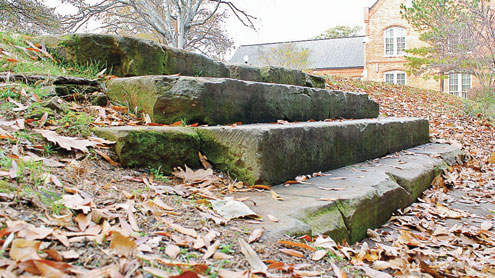Alabama loves mounds. While ours isn’t the most important mound in the state, it’s close. It’s protected by an iron fence thing, adorned with luxurious shrubbery and marked by not one, but two plaques crediting three different societies.
Apparently, everyone wants their name on the most historic pile of dirt on campus.
The Mound is the ruin of Franklin Hall, an antebellum dormitory burned by Union troops in 1865; at least, that’s what the sign says. According to art history professor Robert Mellown, the University used to be peppered with similar sites where they piled up the remains of the torched buildings in 1887. The campus was positively moundy.
But these weren’t monuments to the glory of the University. They were battle scars.
“They left them as reminders of the horrible destruction of war,” Mellown said.
The inspiration goes back thousands of years, when Persia invaded Athens and burned the Greek Acropolis. As the story goes, the Greeks left the ruins in place as a symbol of oppression. UA, which focused on classical education, followed suit.
“Persians had invaded Athens and burned the Acropolis, and now Yankees had invaded Alabama and burned the campus,” Mellown explained.
The rubble was formed into our Mound’s earthen shape in 1887, when the University began to move out of the Reconstruction era and erected new, Victorian buildings. The Crimson White dubbed them “Mounds of Beauty.”
As the campus expanded in 1900, it began to level the mounds, but the Law School staged a rally with students, faculty, and alumnus. By 1910, our little dirt pile had changed from a reminder of destruction to an icon of the University’s history.
While the Mound is a historic snapshot, its archaeological treasures are beneath. Retired history professor Jerry Oldshue excavated a similar site, Madison Hall, in 1975, and two more were opened in 2007 when the University repaved the road between Morgan and Smith. Oldshue said most of the buildings had stone basements which caught the ruins – bricks, furniture and sundries – as the buildings collapsed, buried for any curious archeologist to uncover.
“It was great,” Oldshue said about the excavations. “Here you have artifacts that were there on the morning of April 16, 1885.”
Franklin Hall was originally about 30 by 90 feet, much larger than the mound it left. Mellown said it could be excavated without damaging the historic site. So why has no one unearthed its treasures?
“There was no one interested in it,” said Mellown.
UA’s Archaeology department specializes in Native American civilizations; research into the buried campus is up to enthusiasts such as Oldshue and Mellown, who has written a book on the University’s architectural history. But Mellown said the University can scarcely lay cable or install sprinklers without striking a foundation, well or staircase. The Biology building sits on top of what used to be the campus cemetery.
But the only thing many students know about the mound is that it’s somehow historic.
“I didn’t know what I thought it was,” said sophomore Devan Ray, “I just wanted to have a picnic on it.”
To Ray and many of her friends, the Mound is just another landscape feature; their passing theories range from some kind of stage to a Native American burial site. In 1900, students interacted with the mounds, using them for society tappings and initiation sites, but today, many students avoid it altogether, with its iron barrier and signs reading “KEEP OFF THE HISTORIC MOUND,” and just walk by.
“Now if I could actually find out what it was and people could play on it and read on it and spit on it, I would probably miss it,” Ray said. “I would be able to involve myself in it.”
But whether we know it, the historic pile of dirt remains a shadow of the destruction, hate, courage and triumph that paints the history of the South.









